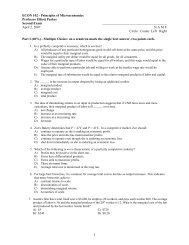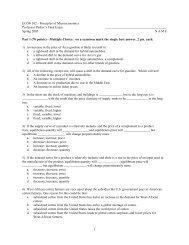ECON 102 - Principles of Microeconomics Professor Elliott Parker ...
ECON 102 - Principles of Microeconomics Professor Elliott Parker ...
ECON 102 - Principles of Microeconomics Professor Elliott Parker ...
Create successful ePaper yourself
Turn your PDF publications into a flip-book with our unique Google optimized e-Paper software.
46. The economic argument for patent protection <strong>of</strong> life-saving drugs is that:A) government intervention may be necessary to enforce superior standards.B) monopolization should always and everywhere be prevented.C) a temporary monopoly provides an incentive that encourages research and innovation.D) Most new inventions are actually public goods.47. Network externalities exist when the value to the consumer <strong>of</strong> a good rises as the number <strong>of</strong> people who usethe good:A) increases.B) decreases.C) remains constant.D) None <strong>of</strong> the above.48. When VCRs were first produced, two different systems were available: VHS and Betamax. VHS eventuallydominated and Betamax disappeared. This was because:A) VHS was unambiguously the better system.B) consumers chose VHS because most <strong>of</strong> the videocassettes available for rental were VHS.C) consumers chose VHS because the majority <strong>of</strong> other consumers were choosing VHS.D) Both b and c.49. The United States lags behind Europe in cell-phone technology because:A) Europe subsidized cell-phone research and the United States did not.B) Europe adopted a common standard for digital-cellular phones and the United States did not.C) the United States allowed no imports <strong>of</strong> cell phones.D) the United States heavily taxes producers <strong>of</strong> cell phones.50. Which <strong>of</strong> the following will not cause a change in demand?A) Change in income.B) Change in the number <strong>of</strong> buyers.C) Change in the good's own price.D) Change in the price <strong>of</strong> related goods, such as complements and substitutes.E) Change in expectations <strong>of</strong> future prices.For 51-52, suppose the government imposes a tax on a specific type <strong>of</strong> market transaction, such as the sale <strong>of</strong> anautomobile.51. Buyers will pay relatively less <strong>of</strong> the tax if: 51(b) Show the effects <strong>of</strong> this tax on the market.A) a sales tax is charged to the seller,instead <strong>of</strong> to the buyer.B) both supply and demand are more elastic.C) both supply and demand are less elastic.D) demand is relatively more elastic than supply.E) supply is relatively more elastic than demand.52. The deadweight loss from the tax will:A) rise proportionately with the tax.B) rise more than proportionately with the tax.C) rise with the tax, but at a decreasing rate.D) rise to a maximum, and then fall as the tax keeps rising.53. If government wants to maximize the revenue from a tax, it should levy taxes on products where demand is:A) unit elastic C) elasticB) downward-sloping D) inelasticPage 8






